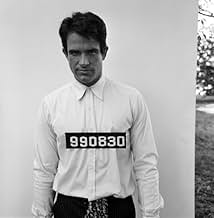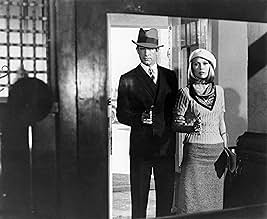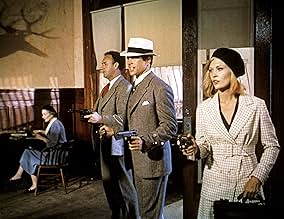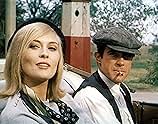अपनी भाषा में प्लॉट जोड़ेंBored waitress Bonnie Parker falls in love with an ex-con named Clyde Barrow and together they start a violent crime spree through the country, stealing cars and robbing banks.Bored waitress Bonnie Parker falls in love with an ex-con named Clyde Barrow and together they start a violent crime spree through the country, stealing cars and robbing banks.Bored waitress Bonnie Parker falls in love with an ex-con named Clyde Barrow and together they start a violent crime spree through the country, stealing cars and robbing banks.
- निर्देशक
- लेखक
- स्टार
- 2 ऑस्कर जीते
- 22 जीत और कुल 29 नामांकन
Martha Adcock
- Bank Customer
- (बिना क्रेडिट के)
Harry Appling
- Bonnie's Uncle
- (बिना क्रेडिट के)
Garrett Cassell
- Cop
- (बिना क्रेडिट के)
Mabel Cavitt
- Bonnie's Mother
- (बिना क्रेडिट के)
Patrick Cranshaw
- Bank Teller
- (बिना क्रेडिट के)
Frances Fisher
- Bonnie's Aunt
- (बिना क्रेडिट के)
Sadie French
- Bank Customer
- (बिना क्रेडिट के)
Garry Goodgion
- Billy
- (बिना क्रेडिट के)
फ़ीचर्ड समीक्षाएं
"Bonnie and Clyde" is a real innovative film in the fact that it does contain some extremely violent content. 1967 was a different time in the cinema. This film was one of the first, if not the first, that really showed violence the way it would be in real life. People bleed when they get shot and they die in gruesome fashions. The film itself is the somewhat true story of the infamous bank robbers who terrorized parts of Texas and Oklahoma in the early-1930s before they were finally terminated by the authorities. Warren Beatty, Faye Dunaway, Gene Hackman, and Michael J. Pollard all received Oscar nominations. Estelle Parsons won one in the Supporting Actress category. Dunaway and Hackman proved to be the finds of the decade and Beatty became the first real star to be an instrumental part in the actual production of the film. Watch for Gene Wilder in a somewhat funny sequence during the course of the action. Unrelenting and overall exceptional, "Bonnie and Clyde" is easily one of the top 10 films of the 1960s and one of the greatest films of all time. 5 stars out of 5.
'Bonnie and Clyde' is not a film about two real people famous for so many bank robberies and murders across the big country... It shows a new kind of fury in which people could be harm by weapons... The film, however, manages to carry the impression that these two youngsters took great pleasure in robbing banks and stores... It also suggests that it was very easy for them to fool the lawas certainly occurred in real life... Though merited punishment caught up with them, audiences laughed at their remarkable deeds and wanted them to get away...
In 'Bonnie and Clyde,' Penn created an emotional state, an image of the 1930s filtered through his 1960s sensibility... The sense of this period reflects Penn's vision of how the 1930s Depression-era truly was, and for all the crazy style and banjo score, this vision is greatly private...
What is also personal about 'Bonnie and Clyde' and constitutes its incomparable quality, is its unusual mixture of humor and fear, its poetry of violation of the law as something that is gaiety and playfulness...
'Bonnie and Clyde' is both true and abstract... It is a gangster movie and a comedy-romance... It is an amusing film that turns bloody, a love affair that ends with tragedy...
A modification between pleasure and catastrophic events is important to the essential aim of the film... In their second bank robbery, a daring and joyful action goes morosely embittered when Clyde is forced to kill an executive in the bank, and real blood pours out from his body...
Bonnie and Clyde take self-gratification posing for photographs with their prisoners But when surrounded by detectives in a motel, they turn into vindictive bandits struggling for their lives... C. W. Moss, specially, brings to mind Baby Face Nelson, when he murders policemen with a blazing machine gun...
One of the stimulating moments in the film happens when Clyde chases Bonnie through a yellow corn field, while a cloud transverses the sun and slowly shadows the landscape... Here the characteristic quality of the Texas countryside and the vague aspect of the story are beautifully communicated......
Penn's masterpiece nominated for ten Academy Awards, including Best Picture, won two Oscars, one for Best Actress in a Supporting Role and another for Best Cinematography...
In 'Bonnie and Clyde,' Penn created an emotional state, an image of the 1930s filtered through his 1960s sensibility... The sense of this period reflects Penn's vision of how the 1930s Depression-era truly was, and for all the crazy style and banjo score, this vision is greatly private...
What is also personal about 'Bonnie and Clyde' and constitutes its incomparable quality, is its unusual mixture of humor and fear, its poetry of violation of the law as something that is gaiety and playfulness...
'Bonnie and Clyde' is both true and abstract... It is a gangster movie and a comedy-romance... It is an amusing film that turns bloody, a love affair that ends with tragedy...
A modification between pleasure and catastrophic events is important to the essential aim of the film... In their second bank robbery, a daring and joyful action goes morosely embittered when Clyde is forced to kill an executive in the bank, and real blood pours out from his body...
Bonnie and Clyde take self-gratification posing for photographs with their prisoners But when surrounded by detectives in a motel, they turn into vindictive bandits struggling for their lives... C. W. Moss, specially, brings to mind Baby Face Nelson, when he murders policemen with a blazing machine gun...
One of the stimulating moments in the film happens when Clyde chases Bonnie through a yellow corn field, while a cloud transverses the sun and slowly shadows the landscape... Here the characteristic quality of the Texas countryside and the vague aspect of the story are beautifully communicated......
Penn's masterpiece nominated for ten Academy Awards, including Best Picture, won two Oscars, one for Best Actress in a Supporting Role and another for Best Cinematography...
The picture tells the lurid criminal story of a famous couple of delinquents, detailing a mythologized biography. In the time of the Great Depression , Clyde Barrow (top-notch Warren Beatty) recently out of jail meets Bonnie Parker(gorgeous Faye Dunaway). She was stark naked, yelling at him out the window while he tried to steal her mother's car. In a matter of minutes they stole a store , fired a few shots and then stole somebody else's car. At that point they had not yet been introduced , subsequently both of whom become usual bank robbers. The antiheroes go across the American Midwest and South robbing banks and stores during the 30s , embarking in a criminal rampage . They form a criminal gang , along with accomplices as Cyde's brother named Buck (incomparable Gene Hackman) and his spouse (Estelle Parsons was Oscar winner), besides an unexperienced young (unforgettable Michael J Pollard). But they're mercilessly pursued by a revenger sheriff (Denver Pyle). "The strangest damned gang you ever heard of. They're young. They're in love. They rob banks." There has never been... You have never seen... a motion picture like this one! They're young... they're in love... and they kill people !.
This classic movie displays drama , a peculiar love story , noisy action, violence and being quite entertaining . A brilliantly directed movie , a groundbreaking film that chronicles the short lives of America's most infamous criminals. In spite of thirty years from film-making still hold well and remains interesting . In the wake of the recently released Sam Peckinpah's Wild Bunch, the flick is plenty of grisly violence including a really violent ending that was extremely polemic. Colorful and glittering cinematography by cameraman Burnett Guffey was Oscar winner, and atmospheric musical score by Charles Strouse . Excellent art direction by Dean Tavoularis and evocative costumes by Theodora Van Runkle. The motion picture was magnificently directed by Arthur Penn . The picture spawned pretty imitators, and created a sub-genre about Great Depression outlaws, such as : Dillinger , Pretty Boy Floyd, Machine Gun Kelly, among others. And other updatings about Clyde Borrow and Charlie Parker life are the following ones : ¨Bonnie Parker story¨(1958) by William Witney with Dorothy Provine and a rendition for TV (1992) by Gary Hoffman with Tracy Needham and Dana Ashbrook.
This classic movie displays drama , a peculiar love story , noisy action, violence and being quite entertaining . A brilliantly directed movie , a groundbreaking film that chronicles the short lives of America's most infamous criminals. In spite of thirty years from film-making still hold well and remains interesting . In the wake of the recently released Sam Peckinpah's Wild Bunch, the flick is plenty of grisly violence including a really violent ending that was extremely polemic. Colorful and glittering cinematography by cameraman Burnett Guffey was Oscar winner, and atmospheric musical score by Charles Strouse . Excellent art direction by Dean Tavoularis and evocative costumes by Theodora Van Runkle. The motion picture was magnificently directed by Arthur Penn . The picture spawned pretty imitators, and created a sub-genre about Great Depression outlaws, such as : Dillinger , Pretty Boy Floyd, Machine Gun Kelly, among others. And other updatings about Clyde Borrow and Charlie Parker life are the following ones : ¨Bonnie Parker story¨(1958) by William Witney with Dorothy Provine and a rendition for TV (1992) by Gary Hoffman with Tracy Needham and Dana Ashbrook.
Although numerous chapters in film manuals have been dedicated to Arthur Penn's violent, jagged, cynical "Bonnie and Clyde"--and, indeed, it kick-started a new permissiveness in American movies which then generated many imitations--the first 20 or so minutes of the picture are pretty awful. Depression-era waitress, bored and thrill-seeking, finds herself drawn to a smooth-talking, reckless hood, an ex-con who, when playfully dared to, robs a general store right in front of her. He's sexually impotent but does have a sympathetic heart for the unfortunates and the working class; she's a high-wire act, strictly amoral and greedy. Their initial meeting outside her house has all the conventions of a standard 1930s drama--and just because the movie's look is generally correct doesn't mean what's happening on the screen is original. Producer Warren Beatty and screenwriters Robert Benton and David Newman were inspired by the French New Wave in regards to the film's approach and style, and their efforts to duplicate the amoral feel of European films paid off (this is a good-looking picture shot by Burnett Guffey, who won an Oscar). However, Arthur Penn's direction isn't visionary, and the multiple car-riding shots with back projection don't seem to break new ground. The film's greatest achievement--aside from its textured look--is the casting: Beatty and Faye Dunaway do marvelous work in the leads; Gene Hackman and Estelle Parsons are also fine as Clyde's brother and sister-in-law (Parsons won the film's second of two Oscars as Best Supporting Actress); Michael J. Pollard is an amiable curiosity as partner C.W.; and there are dandy smaller bits by Denver Pyle, Dub Taylor and Gene Wilder. The violence grows increasingly, steadily, as the film inches toward its queasy conclusion, while Penn juggles (successfully at times) ribald character moments with deadly serious--and bloody--scenes (which also became fashionable). The sweat and the flies, the downtrodden and the righteous, they all get a work-out in this scenario, which, in its best moments, has a prickly-comic and dangerous edge. Nominated for 10 Oscars in all, including Warren Beatty as Best Actor and producer of the Best Picture, Dunaway as Best Actress, Hackman and Pollard in the Supporting Actor category, Penn for his direction, Benton and Newman for their original screenplay and Theodora Van Runkle for her costumes (which started a brief fashion trend). *** from ****
This is one of the greatest cops 'n robbers films of all time. Loosely based upon the real-life escapades of Bonnie Parker and her lover, Clyde Barrow, along with Clyde's brother, Buck, Buck's wife, Blanche, and C. W. Moss, the film details the gang's escapades throughout the American Southwest during the early years of the Great Depression. Action-packed from beginning to end, this film is total dynamite as well as flying lead. Beatty gives a dynamite performance as the vicious Clyde Barrow, who will stop at nothing to escape capture by the law...literally. Dunaway gives a stellar performance as Bonnie, an amateur poetess who allegedly entertained her fellow gang members with long poems. Gene Hackman is superb as Buck Barrow, the joke-cracking gang-member, and Michael J. Pollard is equally adept as C. W. Moss, the sissy-killer of the bunch, who cries after each killing he is involved in. Denver Pyle is great as Texas Ranger Frank Hamer who doggedly tracked he gang and ultimately engineered the ambush of Bonnie and Clyde, after the gang kidnapped him and send pictured of him "bein' just as friendly as pie," with the gang, as Bonnie Parker is alleged to have said. One bizarre note: Buck Barrow was actually shot in the head and after the gang had camped out following his shooting, they left him when "the laws," had surrounded them. Buck lived for several days in a hospital after his capture by the law and actually was pretty coherent several times, giving statements to the police, and even asking for a minister to whom he could give his "final confession," and hopefully receive Divine Absolution. Gene Wilder gives a fine performance as the hapless, would-be, funeral director (or "Undertaker," as they are referred to down south) Eugene Grizzard, and Evans Evans is equally fine as his harried girlfriend, who apparently lied to Grizzard about her age. (When she told Bonnie her true age, she had a very sheepish look on her face while Grizzard gave her an amazed look as if to say: "I didn't know you were THAT old!) Anyway, this is a great film and loads of fun to watch on a rainy Sunday afternoon when there's nothing else to do. It's great to watch with "The Untouchables," 1959, starring Robert Stack and "The St. Valentine's Day Massacre," 1967 starring Jason Robards. I rate this film 10 stars out of a possible 10.
क्या आपको पता है
- ट्रिवियाWarner Bros. had so little faith in the film that they offered first-time producer Warren Beatty 40% of the gross instead of a minimal fee. The movie went on to gross over $70 million.
- गूफ़The film portrays Texas Ranger Frank Hamer as a vengeful bungler who had been captured, humiliated, and released by Bonnie and Clyde. In reality, Hamer was already a legendary Texas Ranger when he was coaxed out of semi-retirement to hunt down the duo. He never met either of them until he and his posse successfully ambushed and killed them near Gibsland, Louisiana, in 1934. In 1968, Hamer's widow and son sued the movie producers for defamation of character over his portrayal and were awarded an out-of-court settlement in 1971.
- भाव
Clyde Barrow: This here's Miss Bonnie Parker. I'm Clyde Barrow. We rob banks.
- इसके अलावा अन्य वर्जनSeveral scenes (most of which can be read in the film's script) were shot but removed or altered for various reasons, either for content or to keep the running time under two hours. These scenes are, in chronological order:
- The earliest versions had Clyde shooting and killing the butcher during their fight. This was toned down to Clyde just shooting the butcher, and finally just pistol whipping him. In real life, speculation still exists as to whether Clyde Barrow actually committed the crime this is based on; although his photo was picked out, the method in which it was executed doesn't fit his MO. In the final cut, there is a brief jump in the film during the fight, where it was spliced from the original, more graphic conclusion.
- After picking up C.W., Clyde and Bonnie take him to a diner where they plan their next robbery.
- After Clyde kills Doyle Johnson (the man on the running board), Bonnie talks with CW in the bathroom while Clyde cleans his guns and laments his actions. In the bathroom CW bathes and Bonnie attempts to seduce him, but changes her mind when CW proves to be less than romantic material. A still from this scene-- Bonnie wearing a slip and Clyde's hat-- can be seen on the DVD.
- A longer scene of Buck and Blanche's approach to the motor lodge. Buck is singing Bible hymns and Blanche scolds him for bringing her to see Clyde.
- A longer version of Bonnie's visit home; she sits in the car and her sister gives her a perm (a portion of this-- Bonnie on the running board getting her hair put up-- exists in the final film).
- A very long sequence in which Bonnie and Clyde get drunk and come to terms with their impending death. They trash their room and rip out the mattress from their bed, turning it into a makeshift coffin. They then put on their best clothes and put makeup on each other so they can see what they will look like when they're dead. The scene concludes with Bonnie and Clyde dancing around CW by candlelight and chanting "The Hearse Song."
- During the Platte City raid, C.W. uses a machine gun to attack the armored car instead of grenades.
- The final shootout, in its earliest form, was done entirely with still photos shown over sounds of machine gun fire and screams, and we never actually saw Bonnie or Clyde dead. The movie ended with the two farmers running towards the car while "Foggy Mountain Breakdown" Played in the background.
- कनेक्शनFeatured in The 40th Annual Academy Awards (1968)
- साउंडट्रैकDeep Night
Music by Charles Henderson
Lyrics by Rudy Vallee
Performed by Rudy Vallee
(heard over the opening credits)
टॉप पसंद
रेटिंग देने के लिए साइन-इन करें और वैयक्तिकृत सुझावों के लिए वॉचलिस्ट करें
विवरण
- रिलीज़ की तारीख़
- कंट्री ऑफ़ ओरिजिन
- आधिकारिक साइट
- भाषा
- इस रूप में भी जाना जाता है
- Bonnie y Clyde
- फ़िल्माने की जगहें
- Red Oak, टेक्सस, संयुक्त राज्य अमेरिका(Bank Robbery)
- उत्पादन कंपनियां
- IMDbPro पर और कंपनी क्रेडिट देखें
बॉक्स ऑफ़िस
- बजट
- $25,00,000(अनुमानित)
- दुनिया भर में सकल
- $2,560
इस पेज में योगदान दें
किसी बदलाव का सुझाव दें या अनुपलब्ध कॉन्टेंट जोड़ें





















